Abstract
This Working Paper provides an overview of the economic, regulatory and geopolitical implications of the trend towards a greater natural gas import dependency of the major natural gas markets and the potential for LNG. It is based on a presentation delivered on 15 October 2007 at the 7th working meeting of the Elcano Royal Institute’s energy group in Gijón, Spain.
In the emerging global gas market, LNG plays an increasingly important role in meeting the demand for natural gas in the EU, the US and Asia. However, LNG is limited by the investment constraints on the accelerated building of liquifaction capacity. As a result, additional pipeline capacity from Russia and other major producing areas under the control of national oil and gas companies is also needed.
The risk factor of the interdependence generated by pipeline gas on the producing regions should not be exaggerated. Energy supplies –but especially pipelines– are an intrinsic bond for mutual long-term relations in both good times and bad due to the high investment costs and the assets’ physical rigidity. Long-term supply and transportation contracts are designed to share the investment and operational risks in a predetermined way to support a balanced long-term relation. On the other hand, in the globalising gas market, both consuming and producing regions actively seek diversification to become less dependent on each other.
Investments are needed and an investor-friendly regulatory regime that is not selective towards the investor is required, as the world will need all available supply options. The US, the EU and Asia might even start to compete in regulatory terms in order to become the most attractive market for investments in new supplies. As a result, more contacts between regulatory agencies and policymakers will develop to coordinate the energy and regulatory policies of the major consuming regions.
Energy Demand and the Emerging Global Gas Market
1.1 World Energy Demand 50% Higher by 2030
World energy demand is rising. Without major energy policy changes, the IEA World Energy Outlook 2007 predicts well over a 50% higher global energy demand by 2030. This demand growth will be accelerated by the fast growing economies of China and India and other emerging economies. Based on existing energy policies, China and India will account for 45 % of this energy demand increase.
Such global growth in energy demand can come from two sources:
- The world population will increase on average by 1% per year over the next 22 years. This adds a city larger than Amsterdam every week to the world’s population. As OECD countries now use over three times more energy per capita than the rest of the world, and because population will mainly grow outside the OECD countries, it can be roughly estimated that a third of the projected increase in world energy demand by 2030 will be caused by global population growth.
- Despite the trend towards a decoupling of energy demand from GDP growth, GDP remains the main driver for this increase in global energy demand. The legitimate aspiration of the population in the emerging markets –as it is in the OECD countries– is aimed at maximising living standards. By 2030, increased living standards are expected to contribute two-thirds of the increase in total energy demand.
Without substantial changes in energy policies, the forecasted world energy demand by 2030 can only be covered with increased hydrocarbon use to avoid major future imbalances. Under these conditions, the switch to low carbon energy systems to combat climate change represents a potentially conflicting objective with that of fulfilling the energy needs of a more prosperous and growing world population. IEA warns that, without changes in the energy policies of the consuming regions, by 2015 a supply crunch might be expected.
The IEA expressed these concerns for future energy supply and demand imbalances when presenting its first results from the World Energy Outlook 2007 last November.
Figure 1. Geographical distribution of proved natural gas reserves
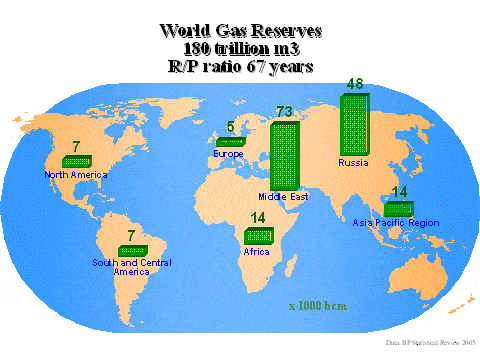
1.2 Supplies and Geopolitical Consequences of LNG Trade
As a bridge to a low carbon energy system, natural gas can certainly make a contribution, given that it is the least polluting fossil fuel. Total world energy production has risen since 1973 by 87%, but natural gas production increased by 240% over the same period. All forecasts point to more natural gas demand as a trend that will both diversify the energy mix and combat climate change. Natural gas is particularly identified as a prominent future source to meet market needs.
As proved natural gas reserves have a lifetime (or a reserves-to-production ratio, R/P) of 67 years at current production levels, for the time being the constraint is not the lack of proved natural gas reserves.
The problem with the increased use of natural gas as a tool for decreasing oil and coal dependency still further is that new natural gas reserves are costly to develop and often only available after long lead times. Major new gas projects like Troll, Sakhalin or Stokhman take over 15 years to develop. Meanwhile, distances to markets are increasing and the total cost for transportation of natural gas by pipeline or LNG tanker are higher than for oil or coal. As with oil, natural gas resources are geographically distributed in a very uneven fashion and are principally located outside the main consumer regions (Figure 1). This reality is starting to give rise to economic and geopolitical questions comparable to those that characterise the oil scenario.
Fifty-six percent of natural gas reserves are located in just three countries (Russia, Iran and Qatar). They have an economically viable choice to ship their gas to either Asia, the US or Europe –wherever the best market might be found–. This could be not only an economic choice but perhaps also one based on which market might best serve short- or long-term geopolitical interests.
Furthermore, consumer countries might not have any guarantee that producing countries and their NOCs (national oil/gas companies) are able (or willing) to make all the necessary investments in time to supply the markets. Investment could transform a sellers’ market into a buyers’ market, thereby putting pressure on prices for not only their new supplies, but also –and even more importantly– their existing supplies. Due to the nature of the gas market, with its limited supply options, the risk exists that producers will be in a position to exercise market power, preventing a buyers’ market from developing. This would be to the detriment of consuming countries; on the other hand, producing countries will always need to maintain good long-term relationships with future markets.
The top seven custodians of natural gas reserves are all national oil companies (NOCs). The supermajors (like Exxon, Shell, BP and Total) reach no higher than 8th position when it comes to the ownership of natural gas reserves. Also, the private supermajors are increasingly dependent on the depletion policies of host countries.
The NOCs of Russia, Iran and Qatar –but also those of Venezuela, Saudi Arabia, Norway, Nigeria, Malaysia, Indonesia and Brazil– manage the bulk of world gas reserves. Some are members of OPEC and many belong to the Gas Exporting Countries Forum in which they discuss their policies at regular meetings. Under international law, natural resources come under the sovereignty of the nation-state and this is not likely to be changed. A consumer/producer dialogue would therefore be the best way to seek mutual benefits from the coordination of respective mutual interests.
Combining all these factors provides for a business environment without many guarantees for the consuming regions in the US, Europe and Asia for the timely arrival of sufficient new future supplies. Investment approval might not only depend on (geo)political considerations; project economics are also often directly influenced by the policies of the host government to guarantee or maximise their portion of the project rent.
Now this is in essence not a new aspect of the gas industry. Energy has always been closely related to (geo)politics; energy is frequently perceieved to be too important for society to be left to private interests and the market, and thus is often considered to be an issue of general –even strategic– interest. The Netherlands was urged by NATO around 1970 to export part of its resources at low netback prices to Italy in order to avoid growing dependence on new Russian supplies. Political pressures were also placed on Germany by the Reagan Administration to avoid an increase in dependency on Russian imports and to build new import pipeline systems.
In the past, when gas import dependency was relatively insignificant for most countries, geopolitics played less of a role across the natural gas industry. There was far less political risk for the industry’s investments when production, transport and the market were all subject to one single legal system. This was the case in most major gas markets like the US, the UK, Argentina and the Netherlands. But even the US, Australia, Canada and Germany had their individual ‘states’ which sometimes lacked coordination or even espoused conflicting views on ‘interstate’ investments.
With an emerging global gas market and a parallel but fast-rising import dependency, the potential for conflicts over gas rents and investments is bound to grow. Contracts with arbitration clauses, together with international contract law, provide by far the best and only guarantee for the investor at the moment. The WTO and the Energy Charter provide only limited comfort in the case of disputes, while many countries have not even signed up to these minimum conditions for energy trade.
When are governments and politicians needed to help the gas business? Preferentially, politicians should only assist in establishing the proper conditions for necessary investments. To serve the general interest, governments have, in principle, the instrument of the law, along with the more specific option of imposing Public Service Obligations to set minimum conditions for investors. These are general rules rather than project-specific rules. Politics should not invade the role of the industry and the state should not try to occupy the driver’s seat with respect to what should be, in essence, a commercial or investment issue. The past has seen short-lived, ill-fated examples of such efforts. In the end, it might help, initially, to push certain initiatives but, in the longer run, it only ends up distorting the markets.
Currently, as hydrocarbon production regions in some major consumer countries like the US and those of north-western Europe are maturing and showing signs of depletion, import dependency in all major consumer regions is on the rise. Presently, high oil prices are signalling a lack of investments all along the supply chain and are clear indications as to the effect that maturing hydrocarbon provinces are having on energy markets. Investment in new production, processing, storage and transport is clearly needed. Adequate policy measures upstream and downstream are necessary to facilitate the investments needed to balance supply and demand, and to protect the environment, as the IEA has shown. But who coordinates such investments and what can industry achieve –within what is allowed by their operating margins and business environment– so as to alleviate future imbalances in supply and demand?
1.3 Demand and Geopolitics
On the other hand, some producing countries are questioning what they call the ‘security of demand’. How certain will the demand be in consumer markets? Will it be strong enough to be able to make reasonable decisions on the levels of long-term natural gas investments? This perspective is heard, in particular, from the Russians and the Algerians, who also claim that regulatory interventions in the market dampen their enthusiasm for new large-scale investments. Some potential interventions, possibly stemming from the growing EU opposition to foreign investors with trading interests in the EU infrastructure, are seen as downright hostile by such producers.
Under these conditions, can consumers be confident in their reliance on such suppliers to make the necessary investments in long-term gas exploitation, particularly in the gas-to-power sector? As a result, is natural gas supply really so reliable that it can contribute to an easing of supply security anxieties and to combatting climate change?
The booming LNG trade and reduction in costs along the LNG gas chain reveals that this form of natural gas transportation is providing at least some new hope for gaining access to new and unexplored resources. But only around 7% of world gas production is now traded as LNG, although admittedly it is quickly gaining market share.
However, by 2015 the EU will need approximately 200 billion cubic metres a year (bcm/yr) to renew existing import contracts and to offset the decline in UK and continental production. This includes the recent decision by Norway to postpone a 20 bcm/yr gas expansion of Troll in order to enhance oil recovery from the field (according to Gasterra). Some of these newly contracted supplies will come through existing infrastructure and the extension of existing contracts, principally with Russia. But can LNG fill the looming gap as an alternative?
Over the past 10 years the LNG trade has nearly doubled. However, in the case that all the new planned LNG receiving terminals are actually realised, there would then be a large surplus in capacity. In the US, experts at the International Gas Union have estimated that of the 50 or so plants that are mentioned as being planned, only seven to 12 will actually materialise by 2015. In the EU, nearly every Member State has planned new or additional capacity to receive LNG.
Figure 2. EU gas supply routes

But the key question is: will there be enough new liquefaction capacity coming down the pipeline to justify all these new plants? The answer is, for the time being at least, no. The major exporting region is the Middle East. Some additional developments can be observed with the booming building efforts taking place in Qatar. However, Qatar is no longer taking on new commitments and, being currently congested with present LNG projects and other activities, has even announced a cooling off period,. Simply put, no spare LNG production capacity is currently available.
There is also a global shortage of experienced workforce and engineering capacity. The prices of nickel and other input materials have been rising steeply, increasing the break-even cost of LNG shipped gas, making pipelined gas more competitive at distances even beyond 3,000 km. Nigeria, Yemen, Oman, Iran, Trinidad and Tobago, Indonesia, Malaysia, Algeria, Russia, Norway and Australia are the principal future producers of LNG, but all have some sort of reservations, or even real constraints, standing in the way of their developing, in the short term, the considerably larger quantities of LNG necessary to meet all of the potential demand of wholesalers seeking alternative supplies.
The expectation is that, over the mid-term, LNG receiving capacity in consuming regions will expand, but this expanded capacity is not expected to be fully utilised. Currently it is estimated that initially around 50% of the newly-added capacity within the Atlantic basin will remain idle. This also provides necessary flexibility for the LNG market to realise its full arbitrage potential. From a producer’s point of view, partially idle receiving terminals do not imply a major increase in costs; a terminal functioning at 50% capacity would not be likely to jeopardise a project, given that production, liquefaction and shipping make up the bulk of total costs.
1.4 Gas-to-power Remains an Uncertain Factor
We will no doubt continue to see the gas market grow; but the actually future rate of growth will remain less clear to investors and will continue to be dependent on various interrelated economic and political factors. Producing regions are carefully estimating the need for additional supply in order not to waste investments on increasingly uncertain demand. In this supply and demand equation, gas-to-power is the key.
The world-wide use of gas for CHP (Combined Heat and Power) and directly for powerplants has risen from 21.5% in 1973 to 34% at present, thereby accounting for some 43% of all additional natural gas production during that period. Over half of the forecasted future increase in gas demand must come from the gas-to-power sector. Nevertheless, the IEA has reduced its forecast for expansion in gas-to-power in its successive World Energy Outlook in recent years.
Since the beginning of the 1990s, when market reform led to more liberalised regional gas markets, there have been great expectations about a coming ‘dash for gas’. At present, half the forecasted increase in demand is still to come from the electricity and CHP sector. The economics of gas-to-power, with its relatively short lead times, combined with the expectations of lower gas prices and abundantly available energy resources, were considered to be favourably influenced by market reform. However, not all the bright forecasts for gas-to-power have materialised. Indeed, in Europe gas-to-power did get an extra push from liberalising energy markets in countries like Spain, the UK and Italy. However, this was less the case in the Nordic countries, France, the Netherlands and Germany, for reasons that were sometimes obvious, like the heavy presence of nuclear power, hydroelectric power and/or coal. Consequently, we have seen the expectations for gas-to-power continually trimmed back by the IEA over the past three years.
A formal EU ban on gas-to-power in Europe was officially lifted in the early 1990s. This ban was imposed to limit the use of gas for what was considered to be a ‘non-premium’ use. Gas should be used primarily for heating households and by industry and small businesses.
By the end of the 1990s, when energy seemed again to be sufficiently available at affordable prices, liberalisation of the energy markets was given priority in the EU. It was generally expected that energy supply and gas price levels would benefit from liberalisation and that security of supply would be decisively enhanced by such energy market reform.
However, despite many changes in markets introducing new structures and market-based instruments, price levels and volatility, along with security of supply, are not perceived to be less problematic today as a result of these liberalising reforms. On the contrary, such issues are back at the top of our political agendas. Gas prices and security of supply are apparently still serving as major sources of uncertainty. For the electricity industry in some countries, notably Germany and perhaps in France and Poland as well, such a state of affairs reinforces the perception that electricity generation cannot be relied upon sufficiently.
This makes forecasting gas demand particularly difficult and uncertain, as gas-to-power accounts for half of the increase in demand projected up to 2020 –in other words, an additional 800 bcm per year remains uncertain–. This uncertainty inevitably reduces demand security for gas producers, particularly as they also see coal-fired power making a comeback in the EU, the US and China, despite the fact that coal is nobody’s first choice when it comes to coming to terms with its environmental impact.
For its World Gas Conference in Amsterdam 2006, the International Gas Union commissioned extensive worldwide studies to identify the drivers behind an expansion in gas-to-power on a regional basis. The general conclusion was that gas-to-power is very much dependent on the local situation and on the price (volatility) of gas. In Figure 2, the main drivers behind gas-to-power are shown by arrows (red for downward and green for upward pressure on ultimate gas demand). The size of the arrow indicates, on average, the relative importance of the parameter. In total, some 800 bcm of gas market growth is dependent on what ultimate influence the combination of these elements will have on investment decisions. By the same token, Figure 2 can be used as an indication for policymakers as to which instruments to focus on in order to influence the share of natural gas in the total energy mix.
Figure 3. Parameters for realising 800 Bcm in extra gas demand from the power sector by 2020
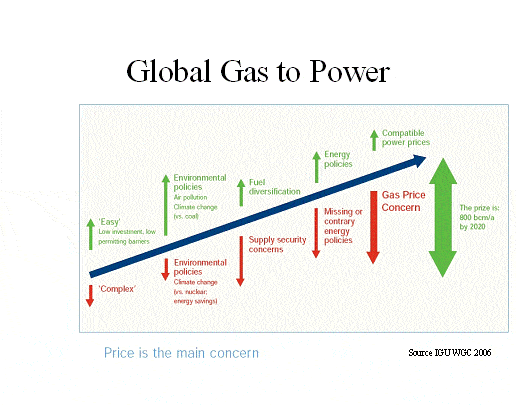
In non-liberalised markets it is possible for producers to get a guarantee for demand in order to secure a long-term dedicated deal, for instance, with a power plant. Such dedicated power deals with dedicated pricing are still conducted in Asia and in newly developing gas markets. The gas supplier delivers at the plant for the agreed dedicated price and the investor at the power plant provides the seller with a long-term guaranteed outlet, based on a long-term contract (fixing volume and price conditions). As a result, investors on both sides can calculate more easily their project economics and request financing for their segment of the gas chain.
In a liberalised market, the power plant investor has to assess his economic calculations based on his expectations of the market price for gas and electricity. In liberalised markets, the volatility in price formation for these commodities is higher than for other commodities (see Figure 5, based on data from Bloomberg). This is sometimes seen as a major uncertainty compared with less volatile coal prices. During periods of high gas prices, coal can push gas to the peak load, severely reducing off take volumes.
Figure 4. Gas price volatility

The emerging global gas market might provide the power sector with more diversified sourcing but it would also generate more import dependency as indigenous gas production is in decline in most consumer markets. How such factors are incorporated into investment decisions by power generators when assessing a choice for gas will remain dependent on local circumstances and on the source and flexibility of the supplier.
A new uncertainty for the decision to build new power generating capacity is the unexpected price increase and price volatility of world coal supplies. Prices that were considered to be mainly determined by the long-run marginal cost of opening new coal mines are recently showing increased price volatility, thus adding more uncertainty to investment decisions for new generating capacity. But also operational decisions in the merit order of power plants might now shift to more use of natural gas fired power stations off peak and more towards baseload. More gas for power demand might be the result.
1.5 The Emerging Global Gas Market
Since 1973 the net import dependency of the OECD countries for natural gas supplies rose from a mere 2% to more than 25%. The major existing markets, along with developing markets like China and India, are becoming increasingly import dependent.
The scramble for energy supplies has translated into oil price levels unheard of only a few years ago. Gas prices have followed. Nevertheless, natural gas has specific characteristics that make it a much less flexible commodity, particularly since it must be transported by pipelines or by sea in the form of LNG. Oil and coal transport is less costly and typically much more flexible.
A global gas market is indeed emerging, particularly as a result of the growing LNG trade across the Atlantic Basin and the increasingly feasible possibility for LNG supplies to choose between market destinations in Asia, the US (both East and West Coasts) and the EU. Cost reduction and arbitrage potential are the main drivers for the emerging global gas market, given that prices in the three principal consumer regions are influenced by cargoes taking advantage of the arbitrage possibilities. Furthermore, investment in Russia no longer looks solely to the EU as the only potential market outlet. Pipelined gas to China or LNG production for export to the US are seriously being considered as alternative options for Russian gas. Norway is expected to deliver its first load of LNG to the US in early 2008.
Figure 5 shows how LNG from the Middle East can now reach all three major gas markets in the US, the EU and Asia. Price differentials of less than US$1 MMBtu can make arbitrage between the regions attractive. LNG spot trading is still relatively modest, but it is nevertheless growing (see Figure 7).
Figure 5. Middle East LNG reaching US – even at price levels of 4 MMBtu
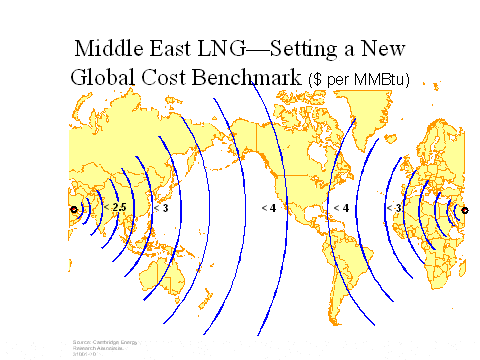
The international trade in LNG on a short-term basis is picking up, but it is still only a small fraction of the regular LNG trade and is dwarfed by the international pipeline gas trade of 640 Bcm/yr.
Figure 6. Transatlantic LNG arbitrage potential
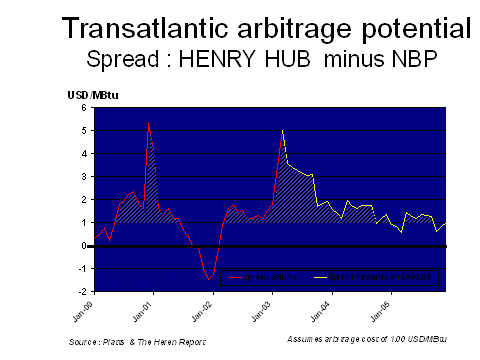
Figure 7. Short-term LNG and spot trading
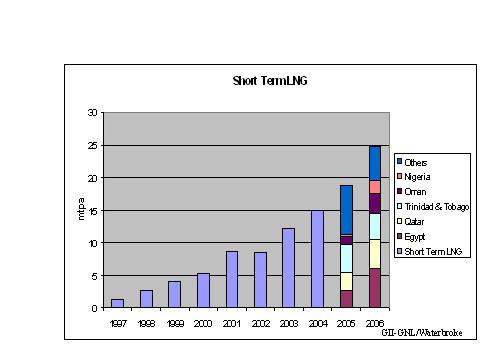
Economic and Geopolitical Consequences of LNG Trade
2.1 Is LNG Trade ‘Oiling’ the Global Energy Market?
LNG trade is growing fast due to the reduction in cost, on the one hand, and high energy prices, on the other hand. Nevertheless, so far only a tiny share of this trade is conducted on a short-term basis. The bulk of the LNG trade is still contracted on a long-term basis between particular producers and wholesale traders or power generators. Furthermore, the pipeline share of the market for cross border gas trade is still overwhelmingly dominant even today.
Assume that over the next 10 years we will experience additional LNG supply on the world market of some 10 mtoe each year. Making a further assumption that all of this incremental supply will go to the EU as the world’s most attractive market. Even in this unlikely case by 2015 90 mtoe of additional LNG would reach Europe and still not even fill half the contractual supply gap. This only demonstrates the continued dependence of the EU on Russia and Algerian gas supplies. But the relationship with Russia and, to a lesser extent, Algeria –the EU’s two principal suppliers– seems to be deteriorating, particularly with regard to energy.
Figure 8. Total and short-term LNG
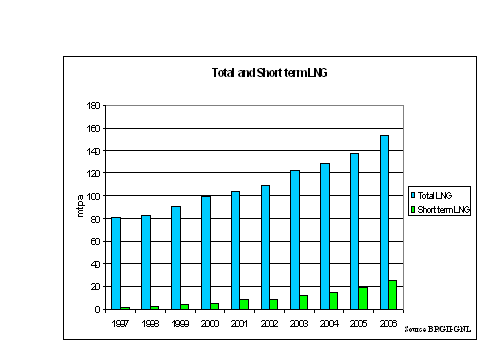
The EU supports import diversification and considers LNG a less risky supply source than pipelined gas from Russia. Although the southern flank of the EU might be less vulnerable to instabilities in Russian supplies as a result of increased LNG imports, it will nevertheless be more dependent on its long-term relationships with the North African countries. In the foreseeable future this will not change.
One aspect of LNG that is often overlooked –but which is present also with oil– is the vulnerability and congestion of sea lane routes. In the future, LNG might have to use the same congested routes through the Suez Canal, the Bosphorus, the Straits of Gibraltar, the English Channel, the Straits of Malacca and even the the Arctic sea lanes.
2.2 Pipelines and Supply Interruptions
For physical supplies in a fully competitive market, the physical flows of gas remain close to the market entry points. Financial trading can cover a much larger geographical area. Through arbitrage and financial trading, gas will stay close to the main landing points and thus regional import dependencies remain or can even be aggravated (see Figure 9), unless the physical pipeline connection remains contractually available at all times for physical diversification –such as for Troll gas to be contracted and physically shipped Spain, or for Dutch gas to physically reach Italy, etc–.
Figure 9. Physical gas supply in a real liquid EU market
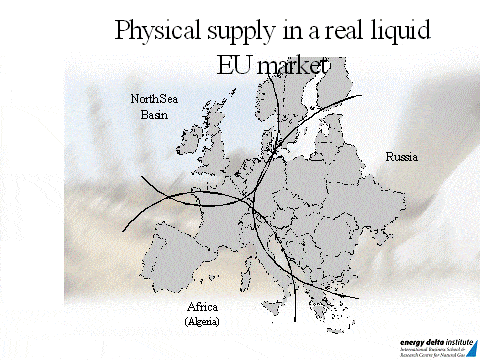
In general, security of supply is enhanced by bringing more LNG to the various entry points in the EU market, thereby reducing direct dependence on Russia and Algeria –but only partly and less than is often supposed by those who seek supply diversity just because of worries over Russia–. The best argument against an overreaction to import dependency on Russian gas is that history has always proved that Russia is a reliable supplier. Over the many years since the 1970s when Russia began to supply Western Europe, there have been no major problems, not even during the Cold War. Contracts were always fulfilled without major disputes. The interruptions in gas supplies caused by Russian disputes with the Ukraine, Belarus and Latvia find their origins in the lack of market-oriented contracts stemming from their past Comecon relations.
This reality notwithstanding, we should expect some level of political interference from Russia within the context of the current transitional phase in its relations with neighbours formerly part of the Soviet Union. Given that many of these countries are now more closely affiliated with the EU than with Russia, the latter is now seeking a new status quo in its relationship with these countries –and not without friction, as they are increasingly required to pay more market-oriented prices for their natural gas imports from Russia–. Russian actions affecting gas supply flows have not been aimed at political or economic targets in the EU. In the case of the Ukraine, the 1 January 2006 interruption was aimed at that country. The result only affected gas transit temporarily while a mere 0.2% of total EU supply was physically affected. The event clearly had more impact on political perceptions than upon actual gas markets and supplies. A similar episode involving Russia and the Ukraine occurred exactly one year earlier, reducing supplies marginally as a result of a commercial dispute over prices, went nearly unnoticed given that, at that time, gas deliveries were not yet so politicised by any of the parties on either side.
With respect to pipeline gas, it is obvious that once the necessary upfront investment has been made the parties involved automatically and naturally enter into a long-term relationship. The rigid physical bond created by the infrastructure might often seem to create a liability for the buyer, now totally dependent on the will of the monopolist supplier, with his hand literally on the tap, to deliver gas on down the line. It appears to be an easy step to place pressure (read: blackmail) on the receiving party by cutting off –or merely threatening (explicitly or implicitly) to cut off– supplies. But this is only a perception; historically, it is an unfounded concern. In reality, a supplier always has to think carefully about his behaviour, real or perceived, towards his markets. A pipeline is costly and worthless without gas flowing through it. A supplier might shoot himself in the foot by even being perceived in such a manner (as Russia seems to be learning now), for once a buyer begins to search for –and finds– alternatives (LNG, perhaps?), it will not be so easy for a monopolistic supplier to find another similar market at the end of the same pipeline allowing for the pipeline to reach full capacity again. The seller might be faced with swallowing a large sunk cost or forced to sell gas far below market prices. At the moment, Russia does not seem to be moving in this direction, that is to say, towards a policy of selling gas below market prices for political purposes. Indeed, it has recently embarked on a policy to raise prices to its former Soviet customers and to its own domestic industrial consumers toward the prices at which it sells gas to Europe by 2011.
2.3 The Pricing of Internationally Traded Gas
Although a global gas market is now emerging, with some arbitration and volume exchange between major markets taking place, a global gas price does not yet exist. The main markets have a tendency to facilitate the convergence of prices but more integration is still needed, either through new pipeline projects or LNG schemes, in order for such a reality to come into being.
How the varying pricing concepts and mechanisms used around the world actually evolve over time and what pricing system(s) will ultimately be favoured, is still hard to foresee. It is likely that different types of projects will produce different outcomes in terms of preferences for the optimal pricing system over the coming decades. The choice depends on market history, project needs and local policy circumstances. Many producing regions still have low gas prices, divorced from the price of alternative competing fuels or the still absent spot market (see Figure). For 2005 the variety in prices is still wide.
This is a snapshot for 2005 which reinforces our previous thesis that gas price volatility over the years has been high.
- The US saw high spot prices in 2005, while Europe experienced lower oil-related gas pricing.
- The Asia-Pacific region is dependent on the ‘B to B’ deals with very limited swap possibilities for LNG cargos. Long-term contracting and historically set prices are defining much of the scene. Therefore no spot market has yet developed. This reality has been reinforced by the general lack of pipeline systems integrating markets, and the absence of a single unified legal system and of harmonised market reform in the region.
- Countries with their own indigenous gas production –like Russia and the South American producer countries– tend to have reduced prices as a result of social and economic policy motives.
Such producer countries –like Russia or the Latin Americans– that charge their customers non-market prices may deprive their (often national) oil and gas industries of the possibilities to develop and maintain production levels and/or to develop new reserves. This tendency is also negative for the goals of energy conservation of energy and of freeing up production so as to serve export markets to meet world energy needs. The average price around the world in 2005 was approximately US$4.50 MMBtu, below the average price levels in the US, the EU and the Asia-Pacific region.
Figure 10. Wholesale gas prices
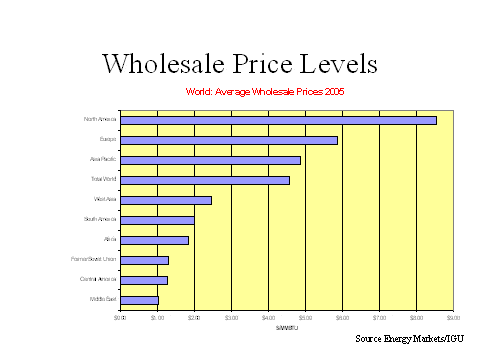
Of the 830 BCM of internationally-traded gas volumes in 2005, 23 % was LNG. The market value principle of pricing the commodity slightly below the prices of competing fuel in the same market was used for over 78% of all LNG traded in 2005.
Figure 11. World LNG imports
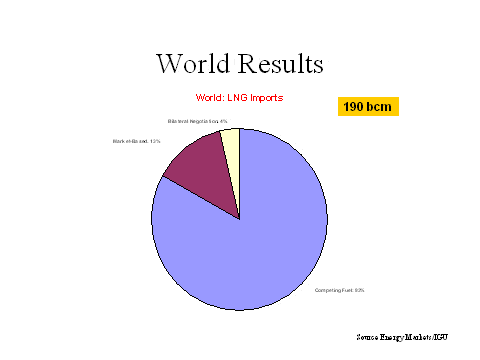
Of the internationally traded gas in 2005, 77% was pipeline gas. A different picture has emerged for this distinct trading realm: only 60 % of the pricing is based on the competing fuel principle while a very large share stems directly from the result of bilateral negotiations (for instance, that between the Ukraine and Russia). Trade based on spot prices for pipelined gas across borders is only 28%.
Figure 12. World pipeline gas imports
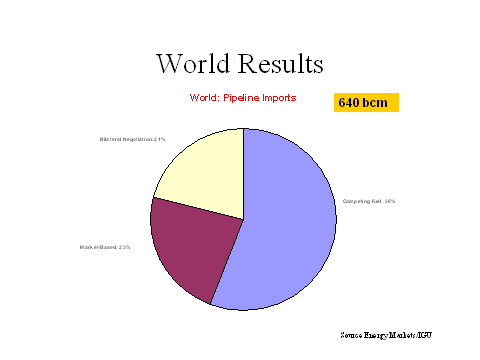
2.4 LNG as a New Source for Security of Supply
LNG supplies can be more easily redirected between and among markets than pipeline gas. Of course there are often contractual rigidities, gas specifications and other hurdles to be taken into account, but they make for less of a barrier that could lead to supply interruption than does the physical and market context of pipeline gas.
Pipeline deliveries create a mutual dependency and a long-term relationship with more potential geopolitical impact than LNG trade could ever bring to bear on the mutual relations between suppliers and consumers. As a measure of the potential geopolitical impact pipelines can have, one need go no further than the many disputes and debates on pipelines to Europe. Pipeline route, conditions and desirability are now controversial political topics, far more debated than the possible different geographic o national origins of LNG imports. This is perhaps a far more interesting topic requiring the attention of policy makers.
But the high hopes are for a more liquid global gas market, not to reduce import dependence, but rather to diversify supplies. LNG comes in smaller chunks of 8 Bcm/yr per train, whereas long-distance pipelines only start with an economy of scale around 20Bcm/yr. It is clearly more difficult to enter markets with such discontinuity in volumes and, as such, LNG trade is attractive both for suppliers and consumers.
Despite the fact that LNG is mainly traded in the context long-term agreements due to the tight schedules of the ships and the enormous investments required all along the supply chain, some short-term deals are conducted, taking advantage of arbitrage opportunities between the major markets. Shipping costs have reached levels that make this possible, provided the gas quality specifications do not become too limiting a factor for trading LNG, particularly trans-oceanic trade on the high seas. Re-routing of ships also means that the often tight return schedules of regular shipments need to provide some flexibility for what will often turn out to be a longer trip. An additional spare tanker will not always be available at a particular moment to load and make the trip. It is therefore clear that LNG trade is not without its own potential rigidities. For these reasons, a global gas market is emerging but the increase in short-term LNG deals is not growing as fast as long-term deals.
Despite such factors limiting the LNG trade, the LNG scene has been set. Even a very few short-term cargos had been able to have an impact on price levels in the US and Europe, as they have been able to exploit arbitrage possibilities. This development has created high hopes for a more liquid and global gas market in the future.
Is There a Developing Regulatory Competition Phenomenon?
3.1 EU Policy
There are three main pillars on which EU energy policy rests (see Figure 13). Since the 1990s these pillars have formed the core of EU policies, although the emphasis has often been on the first of these –increasing competitiveness by creating the internal market–.
The second pillar, policies to promote a sustainable environment, were in the past generally thought to be sufficiently supported by setting and fulfilling the Kyoto targets, introducing emissions trading, labelling energy products for more optimal and efficient consumer use and by creating more customer choice. Therefore, it was assumed that the creation of the internal EU energy market would support environmental objectives once the above-mentioned measures had been implemented.
With respect to the third pillar –security of supply–, the creation of the internal market and its hoped-for effect on competition, was supposed to be a self-regulating instrument that would underpin security of supply. The emphasis during the 1990s was placed on the energy markets as a clear mechanism for increasing competition and broadening customer choice, developments which were presumed to enhance security of supply automatically, almost by definition. Price would signal and orient investment needs, producers would look to the large integrated and liquid market to sell their products at the best price. The more efficient market and lower distribution costs, together with the inflow of sufficient gas into this attractive market, would reduce prices for the end consumer. The EU economy would benefit by positioning itself to compete more effectively on world markets.
Nevertheless, in practice, EU energy policy is currently not much more than the sum of the principal components of the energy policies of its Member States. The EU has only limited power to impose energy policy objectives on its Member States, while the latter can determine, within limits, the structure of their energy mixes and the nature and components of their security of supply measures. The particular aspects of energy policy related to the functioning of the internal market, along with issues of market competition, are by and large determined at the EU level, particularly in the case of cross-border issues.
Figure 13. The three pillars of EU energy policy
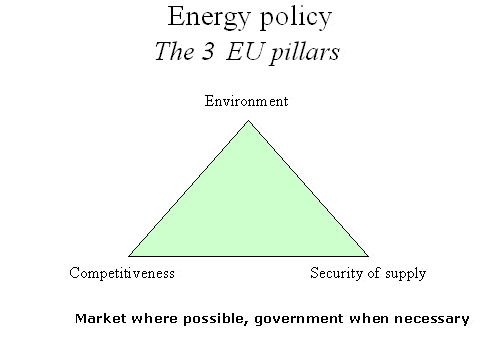
Energy policy is subject to majority voting at the EU level. With the new reform proposed under the now revised (constitutional) Treaty of Lisbon, some sort of EU foreign policy mandate is possible. As such, a common, unified EU energy policy towards energy producer regions could conceivably take shape. However, bilateral contacts are still very often the basis for new initiatives and still tend to support new dedicated projects. The idea of enhanced EU effectiveness through the action of regional infrastructure coordinators remains a new mechanism and has yet to be tested or prove its value.
Since the events of 1 January 2006 in the Ukraine –and as oil prices rise to levels unheard of only a few years ago–, security of supply has occupied a prominent position on the European political agenda. Despite the progress achieved to date in the creation of the internal market, the level of investments needed –for both an authentic internal energy market and the diversification of supply– is far from secured. Neither do producer countries see the EU internal energy market becoming their most attractive market scenario: at least that is the impression one would derive from listening to their complaints in dialogue sessions with the EU. A drive towards diversification is still needed, but the possibilities for becoming less dependent on the present small cadre of suppliers remain limited.
Because it is the industry which must undertake the investments, the balance between ‘market where possible, government where needed’ has yet to be found. Stakeholders are still too absorbed in the struggle over their roles and responsibilities within the EU energy market, to be ready to assume the challenge of cooperation within global energy markets. These changes and challenges do not and will not wait for the EU to first come to terms with all the stakeholders of the internal market.
3.2 Regulatory Measures in Support of Necessary Investments
The financing of necessary investments in new supplies and the imperative to provide a reasonable sharing of the rent is more complicated in the EU than it was in the past. Older, more proved coordination mechanisms such as long-term contracts with oil price indexation and price renegotiation and destination clauses can no longer be viewed as such a solid basis for a project as they once were. Companies are increasingly unbundled and no longer enjoy a well defined and stable market for the development of such long term commitments. Furthermore, there are additional issues to consider:
(1) Gas reserves are increasingly located farther and farther away from the EU’s centres of consumption, and almost exclusively outside the EU.
(2) The majors (IOCs) are increasingly less involved, while NOCs are increasingly dominant in exploration, production and trade.
(3) (Geo)politics have taken on a more dominant presence in the selection of partners and supply routes.
(4) Market price levels and security of demand are both less predictable than in the past due to the competition from more volatile spot price systems in the markets compared with traditional oil-related pricing.
The response within the industry is that producers seek access to markets by attempting to integrate further downstream within the wholesale markets and transportation business. Meanwhile, the EU’s internal market is seeking economies of scale and scope by integrating the electricity and gas business. In response, in an effort to seek security of supply the integrated EU champions are seeking upstream investments wherever possible.
Schematically this trend is visualised in Figure 14.
Figure 14. Upstream and downsteam gas dynamics and business pressures
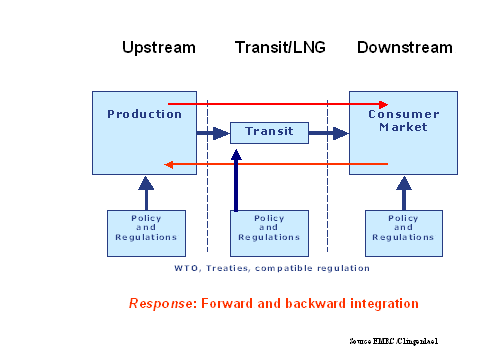
What impact all such changes will have over a relatively short timeframe, of say 10 years, on the generally long-term based gas industry in the EU is still unclear, particularly given that investments typically have a technical/economic lifetime of well beyond 25 years.
3.3 Regulatory Competition is Developing
The networks inside the EU can invest on the basis of their rate base, but they still remain heavily dependent on regulatory exemptions, except in cases where the regulatory regime is properly designed to cover new and existing investments simultaneously. The Trans-European Networks (TEN) Regional initiatives and EU coordinator help provide an initial phase in support of new investments and market integration. But will this bring the positive outcome that is hoped for? Are TEN projects a sufficient basis? Or are (geo)politics of overriding importance in the selection of the support for the needed investments based on the initiatives of the industry. Nord Stream, for instance, is not really supported by all Member States, although it has been on the list of prioritised TEN projects since the beginning of this decade.
In the US, import dependence is growing. However, the regulatory framework has passed the test of time, and adequate decisions seem to be made more easily than in the EU. The Hackberry decision regulates all LNG terminals in a similar way as it does the well-head. This means that any and every investor can use such facilities if necessary, unless ex post abuse of a dominant position is proven. In the EU, on the other hand, for every investment in an LNG terminal an exemption under art. 22 of the second gas directive must be requested (and is often only partially granted).
In the US, as import dependence grows, it is clear that more pipelines and storage capacity will be needed, and adequate measures seem to have been taken along these lines. For storage investments the previously obligatory competition index test is no longer required in order to get permission to build. In the EU, however, the combined regulators (ERGEG) state that all storage facilities are open to Third Party Access (TPA). But investors must ask for exemptions for these facilities as well.
In the US, the regime for new interstate pipelines is to be changed in a way that first-movers willing to invest in the initial capacity would be able to ask for higher tariffs from those that come in later after the investment decision has been taken. In the EU, on the other hand, all users must be charged the same non-discriminatory access regulated tariff.
All three measures in the US are based on the understanding that the US market must become attractive enough for first-mover investors to facilitate the projected future import requirements. Without the necessary investments there will ultimately be insufficient gas for end consumers. The FERC understands that for a well-functioning gas market the rules must be both ‘customer-oriented’ and ‘investor friendly’. This attitude appears to contribute to a more optimal investment climate with fewer major uncertainties than currently exists under the dominant regulatory regime in the EU.
In the US, in general, there seems to be less controversy between the regulator and the industry over the essential investment needs of the latter. Of course, there is a long-standing practice; perhaps this has created more intrinsic trust in the system so as to facilitate a more optimal functioning. In the EU, the liberalisation of the market is much more of an experiment, characterised by a larger role for outside suppliers, that lack of a single legal system, distributed responsibilities and varying historical backgrounds in law and industry structure. Furthermore, the degree of EU liberalisation –right down to the very last household– has never been matched in the US. Such EU liberalisation changes have also been implemented in the relatively very short timeframe of about 10 years to date. As a result of these drastic changes, growing mistrust can be observed everywhere among stakeholders and regulators/authorities. Many disputes, as a result, end up in the courts.
In Asia, market reform is still in its infancy, as physical and financial gas market integration is almost non-existent. The major objective is to conclude business to business deals (often state entities on both sides) in order to satisfy the perceived hunger for energy. Market reform and liberalisation of the energy markets are still to come to this region.
The EU is a major gas market, as large as that of the US. But will demand alone be enough to attract all the needed supplies from the surrounding producer regions? Production levels that depend on ‘gas to power’ demand might fall short of global demand as forecasted by the IEA.
The US and Asia seem to be following a different approach. Whereas the EU views market reform, privatisation, liberalisation and coordination of investment as the way to secure new supplies, the US and Asia seem to bank more on business-to-business deals to secure supply, and as a result, structure the regulatory regime so as to support new investments –instead of other (restrictive) way around, as in the EU–.
In the EU in particular, special exemptions are necessary for almost all new investment proposals, and some of the principal external suppliers might be prevented from investing in the necessary infrastructure as a result of the EC’s 3rd Energy Package, which would force major companies with buying power on the global market to unbundle their generation assets from their transportation and distribution business. Is this really the way to create investor confidence in a new EU-wide gas market?
Such a market –envisioned by the EC– is not the ‘dream market’ for investors, at a time when the EU faces the enormous challenge of securing sufficient supply to its markets on time to meet projected increases in demand. It is clear that the producer nations are searching for ways to use the choice over export markets as a tool to maximise the potential rent from the production of scarce resources.
Analysing the regulatory approach of the US and Asia, one might consider the question of whether the EU is losing out within the realm of regulatory competition, given that in the other major continental markets, regulatory conditions are improved (from the investment perspective) or simply postponed (perhaps to buy time for further consideration)? A proper dialogue on energy that is coherent with an appropriate foreign policy and at one in support of the search for mutual benefits –and which shies from the insistence on imposing ideology– might prove more effective.
Conclusions
(1) A global natural gas market is emerging under the influence of increased LNG trade and the forthcoming additional pipeline capacity connecting continents.
(2) A scramble for energy to supply the needs of existing and specially the emerging markets in Asia and elsewhere is developing, as shown by rising energy prices.
(3) This is aggrevated by the fact that natural gas production is in decline in most of the gas provinces inside the consumer areas.
(4) Major new investments are required in order not to have an energy crisis by 2015 (IEA).
(5) LNG can make a major contribution for the consumer markets to diversify their natural gas supply portfolio but can hardly offset the decline in production in the consumer regions, let alone contribute to the increase in gas demand due to environment objectives, etc.
(6) Thus, the dependance on supplies from producing regions controlled by national oil/gas companies (NOC’s) will not substantially diminish.
(7) Mutual dependance on rigid pipelines, compared to the more flexible LNG supplies, has positive and negative aspects that depend on the situation.
(8) The flexibility of LNG shipments can make supply at times of tenser relations perhaps more vulnerable to one-sided interruptions than pipeline gas.
(9) Pipelines, due to their high investment costs and often long-term contracts to share economic risks, will bond parties in a long-term relation with mutual benefits and hardly any alternative.
(10) Regulatory regimes should support investments. All legitimate investments are welcome when increase supply. Increased supply in times of supply shortages and high prices will always benefit consumers. Thus, a regulatory regime that seeks enhanced competition should be ‘consumer oriented and investor friendly’.
(11) The regulatory regime in the US seems to be more investment oriented than the EU. Investors face more uncertainty in the EU than in the US in obtaining approval for new investments (article 22, unbundling requirements, price regulation, etc). In recent years the US has relaxed some of its major regulatory regimes for LNG terminals, storages and transmission lines.
(12) In the scramble for new energy supplies, could regulatory competition develop between consumer regions to attract new supplies?
(13) Are the enhanced contacts between regulators and energy policymakers developing between the US and the EU leading to a convergence in energy and regulatory policies?
(14) Politicians should support the gas industry in its efforts to invest in new supplies, particularly at times of high energy prices, and not only focus on the market’s end-consumer side.
(15) The Asian gas market is still fragmented due to the lack of market reform and a legal basis for a single regulatory approach. LNG and not a pipeline system is binding the market together. Therefore, there is less need for market rules to be harmonised and interests are diverging. But also Asia will not escape from the emerging global natural gas market that will determine Asian gas price levels in the mid-term.
(16) The national oil companies operating in and outside the producing regions have an increased market power due to energy shortages and can thus serve as an instrument for the geopolitical aspirations of national governments. A beginning can be observed in that NOCs are diversifying into markets beyond their regional consumer markets. They are starting to seek more global operations. But by becoming less dependent and influential in nearby regional consumer markets, this should ultimately water down the ability of their national governments to exercise market power for geopolitical reasons unless a ‘Gas OPEC’ becomes operational.
René Snijder
Energy consultant, lecturer at the Energy Delta Institute in The Netherlands, member of the gas group of the Clingendael Institute and member of IGU committee B (Strategy and Regulation), with over 30 years experience in the natural gas industry, working for the NV Nederlandse Gasunie and two years for Shell

